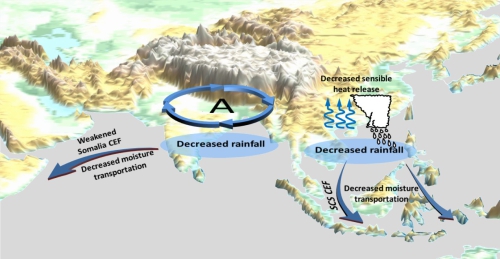Maritime Continent Weakens Asian Tropical Monsoon Rainfall through Australian Cross-equatorial Flows
Date:2019-11-05
Cross-equatorial flows (CEFs) north of the Australia in the lower atmosphere play a pivotal role in mass, moisture and energy transport between the Northern and Southern Hemispheres, and serve as one of the crucial components of the Asian monsoon system.
"CEFs have a profound effect on the weather and climate anomalies in Asia." Said ZHUANG Moran, a Ph.D. candidate from the Institute of Atmospheric Physics under the Chinese Academy of Sciences and the lead author of a new study published in Journal of Climate. "Most previous study focused on either the effect of the orography alone or the response of the global climate due to the land–sea contrast in Maritime Continent with a coarser-resolution model. In our study, we use an atmospheric general circulation model of finer resolution."
"And instead of focusing on only one factor, our study is the first attempt to explore the relative impacts of diverse Maritime Continent (MC) factors on the CEFs north of Australia and tropical Asian monsoon rainfall, and reveals the indirect effect of the MC on weakening precipitation over South Asia.” Said Zhuang’s supervisor Prof. DUAN Anmin, also the corresponding author of the study. The factors covered in this study include the land-sea contrast, orography and surface roughness over the MC.
They found that the Australian CEF would be a homogeneous, thin southerly flow without the MC. The presence of the islands creates three CEFs originating from north of Australia to the South China Sea (SCS), Celebes-Moluccas and New Guinea, and the orography further strengthens the Celebes-Moluccas CEF and shifts the New Guinea CEF. They also reveal that the presence of the islands over the MC directly weakens the moisture transportation and results in decreased monsoon rainfall by roughly a quarter over the SCS. Meanwhile, the rainfall over South Asia decreases by half.

Schematic diagram of the decreased rainfall over the SCS and South Asia during boreal summer with the presence of the Maritime Continent. A denotes the anticyclonic circulation anomaly response to the decreased rainfall over the SCS. (Image by ZHUANG Moran)
They went further to analyze the reasons for the reduced rainfall over the region in South Asian and found the reduction in South Asia is mainly associated with three mechanisms. First, the decreased rainfall over the SCS could induce an anticyclonic circulation response over Bay of Bengal and then suppress the convective activity there. Second, the presence of the islands can intercept the westward propagation of the quasi-biweekly oscillation. Third, the decreased rainfall over South Asia can weaken the Somali CEF, which in turn leads to less moisture transport into South Asia.
"Studying how the CEFs are formed helps us further understand the Asian monsoon circulation and precipitation.” ZHUANG explained the motif of the study.
Citation:
Zhuang, M., and Duan, A., 2019: Revisiting the Cross-Equatorial Flows and Asian Summer Monsoon Precipitation Associated with the Maritime Continent. Journal of Climate, 32, 6803-6821, https://doi.org/10.1175/JCLI-D-18-0749.1.
Contact: Ms. LIN Zheng, jennylin@mail.iap.ac.cn
